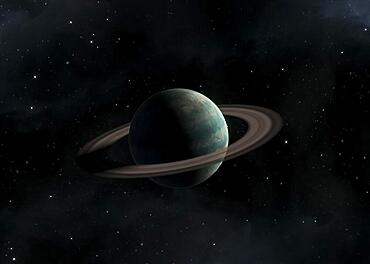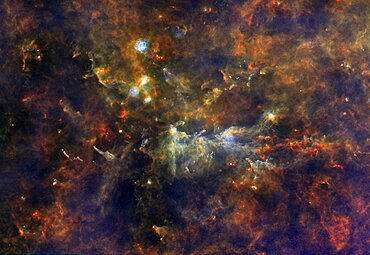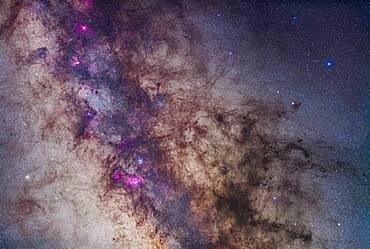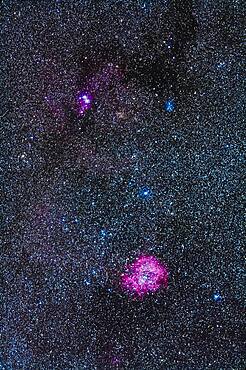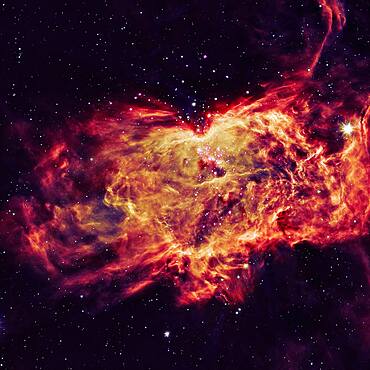Recent searches
Loading...
832-396706 - Diffuse Emission Nebula M42, Orion Nebula, Messier 42, in the constellation Orion with molecular cloud of hydrogen and oxygen ions, Bavaria, Germany, Europe
832-396709 - Emission Nebula NGC2244, Rosette Nebula with open star clusters in the constellation Unicorn, Bavaria, Germany, Europe
832-396708 - Emission Nebula NGC2244, Rosette Nebula with open star clusters in the constellation Unicorn, Bavaria, Germany, Europe
832-396707 - Star cluster Pleiades with reflection nebula, Messier 45, M45
1350-53 - A collection of faint nebulas in southern Cepheus, including the Wizard Nebula
1350-56 - This is the rich region in the centre of the constellation of Auriga with the Flaming Star Nebula, IC 405 at right, and the roundish IC 410 at bottom with the cluster NGC 1893. At top left is the star cluster Messier 38, with small NGC 1907 below it. The small nebula at left is IC 417 around the loose cluster Stock 8. The large elongated nebula at top is Sharpless 2-230. The colourful asterism of stars between IC 405 and IC 410 is the Leaping Minnow or Little Fish, aka Mel 31.
1350-168 - The California Nebula in Perseus, aka NGC 1499, in a set of guided exposures taken January 5, 2018 from home.
1350-28 - The Carina Nebula (aka Eta Carinae) in the southern sky, shot December 11, 2012 from Timor Cottage, Coonabarabran, NSW, Australia. This is a stack of 5 x 12 minute exposures at ISO 400 with the Canon 5D MkII (filter modified) and Astro-Physics 105mm Traveler apo refractor and 6x7 field flattener.
1350-89 - The Horsehead Nebula, B33, below the Belt of Orion and the star Alnitak, along with the bright Flame Nebula, NGC 2024, to the left of Alnitak. Many other bright reflection nebulas populate the field, such as NGC 2023 just left of the Horsehead itself. The quintuple star system Sigma Orionis is right of the Horsehead. The dark Horsehead is set against the bright streak of the emission nebula IC 434.
1350-87 - A mosaic of the region in Cassiopeia and Cepheus containing the main nebulas: the Bubble Nebula (NGC 7635) at lower left, and the Cave Nebula (Sh 2-155) at upper right. At left is also the bright Messier open cluster M52. The small yellowish cluster at right is NGC 7419. The small cluster at lower centre is NGC 7510. The small nebula just left of centre is NGC 7538.
1350-90 - The supernova remnant IC 443 in Gemini near the stars Mu (left) and Eta (right) Geminorum. Slight haze passing thru on some exposures added the star glows.
1350-27 - The nebulas of Orion in the Belt and Sword of Orion area. Including M42, Orion Nebula 9below centre), Barnard's Loop (at left), M78 (small reflection nebula above centre), Horsehead Nebula (centre) and NGC 2024 (above Horsehead). There is faint reflection nebulosity at right -- the frame does not extend right far enough to show the Witchhead Nebula near Rigel.
1350-45 - This is the central area of Cygnus and its bright Milky Way starcloud surrounded by red nebulosity. At left is the star Sadr (gamma Cygni) with the complex of nebulosity catalogued as IC 1318. At centre is the distinct Crescent Nebula, NGC 6888, a expanding nebula created by winds from a hot Wolf-Rayet star. At bottom left is the star cluster Messier 29, though looking a little lost in the rich starfields here. At top is the cluster IC 1311, looking more obvious than M29 but not observed visually and included in the NGC catalog. Odd. At far right are the large and loose star clusters NGC 6883 and NGC 6871, the latter an obvious binocular sight. To the left of Sadr is the small cluster NGC 6910. The dark nebulas B145 and LDN 862 are at right. The small emission nebula at bottom is Sharpless 2-104.
1350-178 - The asterism of the False Cross in Vela and Carina, at left, with Gamma Velorum, a bright blue supergiant star, at right. In between are faint arcs of nebulosity in the Gum Nebula. To the left of Gamma Velorum is the open star clister NGC 2547. Below the bottom star of the False Cross, Epsilon Carinae or Avior, is the large naked-eye star cluster NGC 2516. To the right of the right star of the False Cross, Delta Velorum, is the loose open cluster IC 2391.
1350-140 - The large star-forming region of IC 1396 in Cepheus, taken September 5, 2018 from home in southern Alberta. The wide field includes the bright orange star Mu Cephei, or Herschel's Garnet Star, at top. The Elephant Trunk Nebula is at centre. North is at top.
1350-133 - The amazing area of the southern Milky Way in Carina and Crux, the brightest part of the Milky Way after the galactic core region. At right is the Carina Nebula, with the Southern Pleiades cluster, IC 2602, below it. The Football Cluster, NGC 3532, is at upper left of the Carina Nebula. At centre is the region of Lambda Centauri, with the star cluster NGC 3766, the Pearl Cluster, above the emission nebulosity. At left is the Southern Cross, with the dark Coal Sack at bottom left of the Cross, with thin tendrils extending to the right. To the left of Alpha Cruxis at the bottom of the Cross is the star cluster NGC 4609; aboive Alpha is NGC 4649. To the left of Beta Cruxis at the left side of the Cross is the Jewel Box Cluster, NGC 4755.
1350-24 - The Orion Nebula complex consisting of M42, M43 and the reflection nebula area known as the Running Man Nebula, NGC 1973-5-7. NGC 1981 is the blue star cluster at top north edge. North is up, though in the sky from Australia where this was shot the object appeared upside down compared to this northern-centric view.
1350-10 - The colourful region around yellow Antares (bottom) in Scorpius and blue Rho Ophiuchi (top) in Ophiuchus. The nebulas are largely reflection nebulas, taking on the colour of the stars embedded in the nebulas. However, the field also contains a lot of emission nebulosity, hydrogen gas glowing red and magenta. Plus there are fingers of brown dark dusty nebulosity. It is one of the most colourful regions of the sky.
1350-58 - This is the nebula rich region in the constellation of Monoceros the Unicorn with the dark Cone Nebula (left of centre) and the small V-shaped and bright Hubble's Variable Nebula at bottom, a reflection nebula that varies in form and brightness. Above the Cone Nebula is the triangular Christmas Tree Cluster, NGC 2264, here upside down as the bright blue star 15 Mon is the base of the tree. The large region of nebulosity is Sharpless 2-273. The V-shaped dark nebula above centre is LDN 1603.
1350-35 - A mosaic of the region around the Small Sagittarius Starcloud and Dark Horse dark nebula complex. The field takes in the Milky Way from the Lagoon Nebula at bottom to the Eagle Nebula at top left. In between from top to bottom are the Swan Nebula (M17), and the Small Sagittarius Starcloud (M24). Flanking the bright M24 starcloud are the large open clusters M23 (right) and M25 (left). At bottom left is the M22 globular star cluster. The prominent dark nebula at right is the large Pipe Nebula (B78) with the small Snake Nebula (B72) above it. The whole complex is visible to the naked eye as the Dark Horse.
1350-150 - The North America Nebula (NGC 7000) and associated nebulosity and star clusters, near the bright blue-white star Deneb in Cygnus.
1350-105 - The spectacular field of Messier 8 and 20 emission and reflection nebulas in Sagittarius, with M8, aka the Lagoon Nebula below, and M20, the Trifid Nebula, above, all set in the rich starfields of the Milky Way. The diffuse nebula left of M8 is NGC 6559. Two globular clusters, NGC 6544 and NGC 6553, sit below and to the left (east) of M8. The Messier open cluster, M21, sits above M20.
1350-79 - The Belt and Sword region of Orion, with the Orion Nebula, Messiesr 42 and 43, at bottom. Below the left star of the Belt, Alnitak, is the famous Horsehead Nebula, while above it is NGC 2024, aka the Flame Nebula. At very top left is Messier 78, while part of Barnard's Loop arc across the field at left. The field is filled with other faint red emission and blue reflection nebulas. The large loose open cluster Collinder 70 surrounds the middle star of the Belt, Alnilam.
1350-110 - Mars (at top) and Saturn (at left) in Scorpius (or thereabouts - Saturn is technically in Ophiuchus) above Antares and the dark and reflection nebulas around Antares. The globular M4 is visible to the right of Antares.
1350-17 - Nebulosity in the heart of Cygnus the Swan, including the North America Nebula and Pelican Nebula at left (NGC 7000 and IC 5070) and Gamma Cygni complex at right (IC 1318). The Crescent Nebula (NGC 6888) is at lower right. This is a stack of 5 x 4 minute exposures at f/2 with the 135mm lens and modified Canon 5D MkII at ISO 800, plus another three similar exposure images but taken thru the Kenko Softon filter for the star glows. Taken from home Sept 10, 2013.
1350-94 - The Orion Nebula, M42 and M43, with surrounding associated nebula and star clusters, such as the Running Man Nebula above (NGC 1975) and blue star cluster above it, NGC 1981.
1350-47 - This is the Belt of Orion with its three blue stars across the top of the frame (L to R: Alnitak, Alnilam, and Mintaka), with the iconic Horsehead Nebula (aka B33) below Alnitak, with the dark Horsehead set against the bright nebula IC 434, aka Orion's Dagger. The pinkish nebula above Alnitak is NGC 2024, the Flame Nebula. The small blue reflection nebula left of the Horsehead is NGC 2023, with smaller IC 435 to the left of it. The field is filled with the large open cluster Collinder 70. The multiple star at bottom left of centre is Sigma Orionis. Many other smaller bits of reflection nebulas populate the field in and around the Belt.
1350-82 - The area of the Rosette Nebula (bottom) and Christmas Tree Cluster (top) in Monoceros with the Fornax Lightrack tracker and 200mm lens + Canon 5D MkII. The nebulosity at top includes the Cone Nebula.
1350-22 - The complex area of clusters and nebulosity in central Auriga, including: M38 the Starfish Cluster and its smaller companion cluster NGC 1907; the emission/reflection nebulas NGC 1931, IC 417, IC 410 and IC 405 (from right to left here). Magenta and cyan (from emission and reflection components) IC 405 at right is the Flaming Star Nebula. Between IC 405 and IC 410 is the asterism known as The Little Fish.
1350-12 - A mosaic of the region around the centre of the Milky Way in Sagittarius and Scorpius. The field takes in the Milky Way from the Cat's Paw Nebula at bottom edge to the Eagle Nebula at top left. In between from top to bottom are the Swan Nebula (M17), the Small Sagittarius Starcloud (M24), the Trifid and Lagoon Nebulas (M20 and M8) and the open clusters M6 and M7. The prominent dark nebula at right is the large Pipe Nebula (B78) with the small Snake Nebula (B72) above it. The whole complex is visible to the naked eye as the Dark Horse.
1350-49 - The large emission nebula IC 1805 in Cassiopeia, aka the Heart Nebula. The round nebula at top right is NGC 896. The large loose star cluster at centre is Mel 15; the star cluster at left is NGC 1027. The small cluster below NGC 896 is Tombaugh 4.
1350-108 - A mosaic of the Sword and Belt region of Orion the Hunter, showing the diverse array of colourful nebulas in the area, including: curving Barnard's Loop, the Horsehead Nebula below the left star of the Belt, Alnitak, and the Orion Nebula itself as the bright region in the Sword.
1350-30 - The False Comet Cluster area of southern Scorpius, which includes the open cluster NGC 6231 and emission nebula IC 4628, and open cluster NGC 6242 at top. This is a superb binocular field.
1350-123 - NGC 7000, the North America Nebula, with the Pelican Nebula, IC 5067, at right, in Cygnus, taken from home November 21, 2016 as part of testing of the Explore Scientific FCD100 102mm apo refractor. This is a stack of 5 x 6-minute exposures at f/7 with the ES field flattener, and at ISO 1600 with the filter-modified Canon 5D MkII. Star diffraction spikes added with AstronomyTools actions.
1350-65 - Messier 16, the Eagle Nebula in Serpens. The cluster embedded in the nebula is NGC 6611. The small open cluster above is Trumpler 32.
1350-11 - The Belt of Orion with the Horsehead Nebula at botton, the dark nebula set in the bright emission nebula IC 434. The nebula at left of the Zeta Orionis (aka Alnitak) is the Flame Nebula, NGC 2024. The reflection nebula at upper left is the M78 complex with NGC 2071. The other Belt stars are Alnilan (centre) and Mintaka (upper right). The field contains a wealth of other blue reflection and red emission nebulas.
You reached the end of search results

